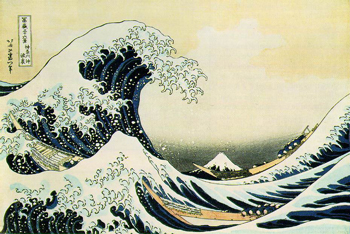| Search Art Prints | ||||||||||||||||||||
| Search Artists | ||||||||||||||||||||

|
||||||||||||||||||||
|
|
|||||||||||||||||||

The Great Wave at Kanagawaalso known as Tsunami

|
Hokusai's legendary Kanagawa-oki nami-ura has become almost synonymous with Japanese art abroad. It is also unarguably the most famous ukiyo-e, or wood-block print, from the Edo period (1603-1867), the heyday of this celebrated Japanese art form.
Hokusai created this masterpiece in the early 1830s, when he was in his early 70s, a master of the art form fully mature in his skill and technique. Based on tamer studies Hokusai drew around the turn of the century, thirty years earlier, this print fully realizes the tremendous power of the sea. It is a work of violent intensity, capturing the terrifying and awe-inspiring might of nature. It is simultaneously, though, a work of graceful beauty and simple construction.
The wave is the most potent element of the painting, even dwarfing Mount Fuji, barely visible in the background. Indeed, the curves of the wave and the skiffs below it mimic the graceful slopes of Fuji, but in vigorous motion, in opposition to the mountain's static power. The cresting tip of the wave bears down on the skiffs like the claws on tentacles of a huge animal, while the fisherman cower before it, almost in supplication to this inanimate tower of water.
Despite the power of this piece, the design uses relatively few color blocks: three shades of blue for the water; yellow for the boats; dark gray and pale gray for the sky around Fuji and for details on the boats; and pink for the irregular clouds. Of particular note, too, are the tips of the wave: the line of each is broken slightly under the tip. Such detail must have required an extraordinary feat of cutting skill.











